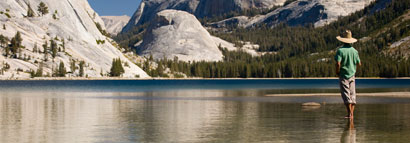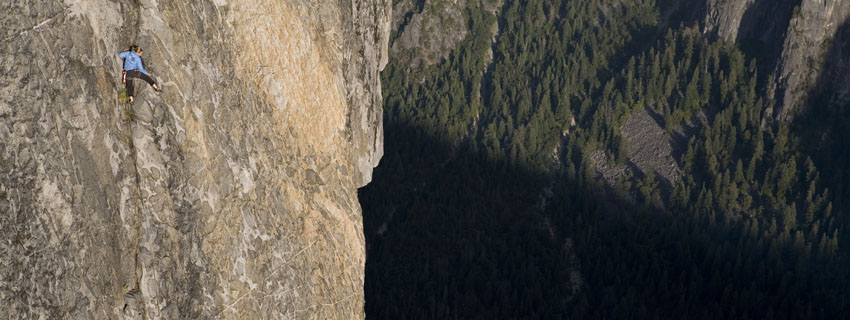
When Abraham Lincoln set aside Yosemite Valley and the Mariposa Grove in 1864 he marked one of the first times in history that a federal government preserved an area for all to enjoy. Over a hundred years later, in 1984 Congress designated 95% of what is today Yosemite National Park as the Yosemite Wilderness.
Each year millions of people travel from around the world to visit Yosemite’s breathtaking granite formations and sublime high alpine landscape. Covering an area approximately the size of Rhode Island, the Yosemite wilderness includes both the Tuolumne and Merced watersheds. During the summer months the Tioga Road (Hwy 120) traverses the park and provides quick access to the high country.

Tuolumne River and Lembert Dome in Tuolumne Meadows
GETTING THERE
The Yosemite Wilderness, unlike many other areas in the Sierra, is accessible from a variety of roads and directions: Hwy 140, 120, and 49 from the west, and 120 (Tioga Road) from the east. Over 700 miles of trail crisscross this wilderness, starting at various points throughout the park.
- Directions to Yosemite
- See the sidebar for public transportation options
WILDERNESS PERMITS
Permits are required for all overnight trips in Yosemite’s wilderness. (Why)? They are not required for day use, except for the Half Dome Cables.
Wilderness permits are issued to a limited number of people per trailhead per day. Visit Yosemite’s website for information on obtaining a permit, or follow the links in the sidebar.
John Muir Trail (JMT) Lottery, and Donohue Pass Exit
Originating in Yosemite Valley and continuing for 211 miles through several Sierra Wilderness areas, the John Muir Trail is a thru hiking adventure. Due to its increasing demand, additional regulations have been put in place to continue to provide access to these remote locations. To help process the many JMT applications the park receives, Yosemite has created a separate lottery to process JMT permits.
In addition to a Wilderness Permit, hikers intending to hike south of Donohue Pass must also obtain a Donohue Pass Exit Permit. This additional quota was implemented in 2015 and provides access for JMT hikers heading south towards Reds Meadow and beyond.
The Donohue Pass Exit quota is only available to hikers starting from the following 5 trailheads
- Happy Isles → Little Yosemite Valley
- Happy Isles → Sunrise/Merced Lake pass thru
- Glacier Point → Little Yosemite Valley
- Sunrise Lakes
- Lyell Canyon
All Wilderness regulations apply on the JMT and visitors are responsible for additional regulations in subsequent wilderness areas. Frequently Asked Questions and Additional Info

Half Dome after an October storm, seen from the summit of El Capitan
Half Dome
Half Dome permits can be obtained as part of a overnight wilderness trip or as a day trip. Depending on how you want to experience Half Dome, the permit process is different.
For overnight wilderness trips, apply for Half Dome permits along with your wilderness permit
For day trips, permits can be obtained by visiting recreation.gov, or by calling 877/444-6777. Half Dome Day Use permits are available ONLY through this service.
MAXIMUM GROUP SIZE
No more than 15 people and 25 head of stock are allowed on overnight trips. Groups going off-trail more than 1/4 mile are limited to 8 people. Stock are allowed to travel up to 1/4 mile off designated trails only for watering, rest stops, overnight camping, and grazing. (Why?)
BEARS
All visitors must store all “food” properly throughout Yosemite National Park. “Food” (including all food and drinks, regardless of packaging, along with trash, toiletries, and other scented items) must be stored in either an allowed bear-resistant food canister or food locker. Hanging food is illegal throughout Yosemite.
- Keep Bears Wild
- Yosemite’s food storage info page
- List of allowed bear canisters
- Where to rent bear canisters
- General food storage and bear info
CAMPFIRES
Fire regulations are subject to change, and visitors are responsible for the current restrictions in place. Campfires are never allowed above 9,600 feet (roughly “tree line” in most areas). When no additional seasonal restrictions are in place, campfires are permitted below 9,600 feet, only in existing fire rings, using only small pieces of dead and down wood. (Why)?
PETS
Pets are not allowed in Yosemite Wilderness. As a rule of thumb, pets are usually not allowed away from developed areas in National Parks. If you plan to hike or backpack during your visit to Yosemite, best to leave your dog elsewhere during your trip. Visit Yosemite’s website for more information.
LITTLE YOSEMITE VALLEY
More than 20% of Yosemite’s wilderness travelers pass through Little Yosemite Valley (many on their way to Half Dome). The impacts from such heavy use have resulted in special management of this area. If you camp in Little Yosemite Valley, please abide by the following regulations:
- Camp only within the campground boundaries (in order to limit damage to the fragile riverbank and an important archeological site, the campground was moved back from the river).
- Store anything with a smell (food, bug spray, deoderant, trash etc.) in the provided bear boxes, or in an allowed food storage container.
- Use the composting toilet to help reduce the substantial human waste problem.
- “Build camp fires only in the two public fire rings (to be used between 5 and 10 pm) to reduce air pollution, proliferation of charcoal and scorched rocks, and damage to vegetation. Make sure there are no additional campfire restrictions in place.
- Carry a water storage container with you to reduce trips to the river and use the designated paths to acquire water.
WEATHER
Weather can be drastically different depending on where you are in the park, and it can change quickly. Temperatures can vary 20 to 30 degrees as you change elevation. There may be spring flowers in Yosemite Valley and snow in Tuolumne Meadows at the same time. In addition to weather forecasts, check Yosemite’s current conditions using the links in the sidebar.

Tenaya Lake along the Tioga Road (Hwy 120) on a perfect summer afternoon
